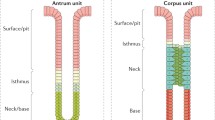Abstract
Spasmolytic polypeptide (SP/TFF2)-expressing metaplasia (SPEM) is induced by oxyntic atrophy and is known as a precancerous or paracancerous lesion. We seek to determine whether the gastrin receptor or H2 histamine receptor influence the development of SPEM. DMP-777 was administered to gastrin receptor and/or H2 receptor-deficient mice and wild-type mice. Gastric mucosal lineage changes were analyzed. The mucosa from double knockout mice and H2 receptor knockout mice contained elevated numbers of dual TFF2 and intrinsic factor immunoreactive cells even before DMP-777 treatment. All genotypes of mice showed SPEM after 7-day treatment. In all types of knockout mice, the number of TFF2 immunoreactive cells remained elevated after cessation of treatment. The H2 receptor and gastrin receptor do not affect emergence of SPEM. However, it is suggested that the absence of H2 receptor signaling causes a delay in the maturation of chief cells from mucous neck cells.







Similar content being viewed by others
References
Karam SM, Leblond CP. Dynamics of epithelial cells in the corpus of the mouse stomach III. Inward migration of neck cells followed by progressive transformation into zymogenic cells. Anat Rec. 1993;236:297–313. doi:10.1002/ar.1092360204.
Stepan V, Ramamoorthy S, Nitsche H, Zavros Y, Merchant J, Todisco A. Regulation and function of the sonic hedgehog signal transduction pathway in isolated gastric parietal cells. J Biol Chem. 2005;280:15700–15708. doi:10.1074/jbc.M413037200.
Murayama Y, Miyagawa J, Higashiyama S, et al. Localization of heparin-binding epidermal growth factor-like growth factor in human gastric mucosa. Gastroenterology. 1995;109:1051–1059. doi:10.1016/0016-5085(95)90562-6.
Dempsey P, Goldenring J, Soroka C, et al. Possible role of transforming growth factor alpha in the pathogenesis of Ménétrier’s disease: supportive evidence form humans and transgenic mice. Gastroenterology. 1992;103:1950–1963.
Sharp R, Babyatsky M, Takagi H, et al. Transforming growth factor alpha disrupts the normal program of cellular differentiation in the gastric mucosa of transgenic mice. Development. 1995;121:149–161.
Kobayashi T, Tonai S, Ishihara Y, Koga R, Okabe S, Watanabe T. Abnormal functional and morphological regulation of the gastric mucosa in histamine H2 receptor-deficient mice. J Clin Invest. 2000;105:1741–1749. doi:10.1172/JCI9441.
Ogawa T, Maeda K, Tonai S, Kobayashi T, Watanabe T, Okabe S. Utilization of knockout mice to examine the potential role of gastric histamine H2-receptors in Menetrier’s disease. J Pharmacol Sci. 2003;91:61–70. doi:10.1254/jphs.91.61.
Dockray G, Varro A, Dimaline R, Wang T. The gastrins: their production and biological activities. Annu Rev Physiol. 2001;63:119–139. doi:10.1146/annurev.physiol.63.1.119.
Koh TJ, Goldenring JR, Ito S, et al. Gastrin deficiency results in altered gastric differentiation and decreased colonic proliferation in mice. Gastroenterology. 1997;113:1015–1025. doi:10.1016/S0016-5085(97)70199-9.
Li Q, Karam S, Gordon J. Diphtheria toxin-mediated ablation of parietal cells in the stomach of transgenic mice. J Biol Chem. 1996;271:3671–3676. doi:10.1074/jbc.271.7.3671.
Nomura S, Baxter T, Yamaguchi H, et al. Spasmolytic polypeptide expressing metaplasia to preneoplasia in H. felis-infected mice. Gastroenterology. 2004;127:582–594. doi:10.1053/j.gastro.2004.05.029.
Nomura S, Yamaguchi H, Ogawa M, Wang T, Lee J, Goldenring J. Alterations in gastric mucosal lineages induced by acute oxyntic atrophy in wild-type and gastrin-deficient mice. Am J Physiol Gastrointest Liver Physiol. 2005;288:G362–G375. doi:10.1152/ajpgi.00160.2004.
Ogawa M, Nomura S, Varro A, Wang TC, Goldenring JR. Altered metaplastic response of waved-2 EGF receptor mutant mice to acute oxyntic atrophy. Am J Physiol Gastrointest Liver Physiol. 2006;290:G793–G804. doi:10.1152/ajpgi.00309.2005.
Fukushima Y, Matsui T, Saitoh T, et al. Unique roles of G protein-coupled histamine H2 and gastrin receptors in growth and differentiation of gastric mucosa. Eur J Pharmacol. 2004;502:243–252. doi:10.1016/j.ejphar.2004.09.013.
Fukushima Y, Shindo T, Anai M, et al. Structural and functional characterization of gastric mucosa and central nervous system in histamine H2 receptor-null mice. Eur J Pharmacol. 2003;468:47–58. doi:10.1016/S0014-2999(03)01668-6.
Nagata A, Ito M, Iwata N, et al. G protein-coupled cholecystokinin-B/gastrin receptors are responsible for physiological cell growth of the stomach mucosa in vivo. Proc Natl Acad Sci USA. 1996;93:11825–11830. doi:10.1073/pnas.93.21.11825.
Goldenring JR, Poulsom R, Ray GS, Wright N, Meise KS, Coffey RJ Jr. Expression of trefoil peptides in the gastric mucosa of transgenic mice overexpressing transforming growth factor-alpha. Growth Factors. 1996;13:111–119. doi:10.3109/08977199609034571.
Ramsey V, Doherty J, Chen C, Stappenbeck T, Konieczny S, Mills J. The maturation of mucus-secreting gastric epithelial progenitors into digestive-enzyme secreting zymogenic cells requires Mist1. Development. 2007;134:211–222. doi:10.1242/dev.02700.
Yamaguchi H, Goldenring JR, Kaminishi M, Lee JR. Identification of spasmolytic polypeptide expressing metaplasia (SPEM) in remnant gastric cancer and surveillance post-gastrectomy biopsies. Dig Dis Sci. 2002;47:573–578. doi:10.1023/A:1017920220149.
Singh P, Wu H, Clark C, Owlia A. Annexin II binds progastrin and gastrin-like peptides, and mediates growth factor effects of autocrine and exogenous gastrins on colon cancer and intestinal epithelial cells. Oncogene. 2007;26:425–440. doi:10.1038/sj.onc.1209798.
Acknowledgments
We thank Dr. N. Wright, Dr. David Alpers, and Dr. Adam Smolka for gifts of antibodies. This work was supported in part by a Merit Review Award to J.R.G. from the Department of Veterans Affairs. This work was also supported in part by Grants-in-Aid for scientific Research to S.N. from the Japan Society for Promotion of Science.
Author information
Authors and Affiliations
Corresponding author
Rights and permissions
About this article
Cite this article
Aikou, S., Fukushima, Y., Ogawa, M. et al. Alterations in Gastric Mucosal Lineages Before or After Acute Oxyntic Atrophy in Gastrin Receptor and H2 Histamine Receptor-Deficient Mice. Dig Dis Sci 54, 1625–1635 (2009). https://doi.org/10.1007/s10620-009-0832-2
Received:
Accepted:
Published:
Issue Date:
DOI: https://doi.org/10.1007/s10620-009-0832-2




